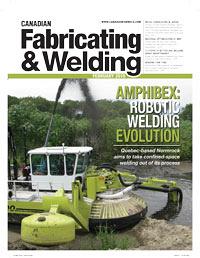- FMA
- The Fabricator
- FABTECH
- Canadian Metalworking
Amphibex digs into new manufacturing era with robotic welding
Quebec-based Normrock aims to take confined-space welding out of its process
- By Treena Hein
- February 27, 2019
- Article
- Automation and Software
After 30 years, production of Canada’s Amphibex amphibious excavator is about to move to the next level with the addition of a specialized robotic welding machine on the assembly line of its manufacturer, Normrock Industries.
Norm Grant invented the Amphibex in the 1980s to simplify a multitude of tasks in water and at shorelines that traditional excavators can’t manage. They include breaking ice, installing pipelines and submarine cables, cleaning wastewater treatment ponds, and removing vegetation and debris from waterways.
“The Amphibex is tremendously powerful and manoeuvrable in these types of environments,” said Grant, who serves as CEO of Normrock Industries, founded in Terrebonne, Que., in 1987. “The propeller can be raised in shallow waters to protect vegetation and avoid disturbing riverbeds. It also uses highly sophisticated positioning devices to keep it stable.”
These devices include four large round stabilizers that anchor the machine to ice or any other handy stable surface. Each stabilizer is on an articulated arm and operates independently, so the vessel can be tilted as well as telescopically extended for various depths. Large ball-shaped floaters are placed around the front stabilizers; these provide additional support to maintain the balance of the machine when the excavating arm takes up a load or swings to the side.
The first ice-breaking request came in the early 1990s. Since then the Amphibex has been used to prevent spring floods on the Red River in Manitoba, the Nechako in British Columbia, several areas in Quebec, and many other places beyond. The machines also have been used to clean up the infamous crude spill on the Kalamazoo River in Michigan, used for extensive dredging along the Tigris in Iraq and the Danube in Europe, and for other tasks around the globe.
For a long time Normrock offered only one model, but starting in 2005, the firm met countless requests for something larger and began producing more powerful units capable of handling greater depths and with heavier lifting capacity and dredging power. However, the requests for even greater capacity didn’t stop. In 2011 Normrock added the Amphibex 1000, a complete redesign with two engines and a new hydraulic system. And in 2015 the ninth Amphibex model hit the market, the mammoth 1200 model.
“I doubt we’ll make a bigger [model than the 1200], as there are good ways of two or more machines to work together,” Grant said.
Indeed, for a very recent reclamation project in Canada’s oilsands area, 10 machines are working together. “It’s a very big job,” said Grant. “In some of these situations, we are contracted to operate our own machines, and in some cases, we operate them for private companies. Some jobs are better done with our project managers and expert operators to make sure things are done right. We obviously also provide training. We have many government projects.”
About 200 Amphibex machines now are in use around the world.
Manufacturing process

Normrock CEO Norm Grant said all potential welder hires are tested for their skill set and observed for suitable personality traits. Once hired, they are trained for certain parts of the Amphibex manufacturing process, but they are also moved around to other parts of the process. This prevents boredom, he explained, and also ensures that all or most members of the welding team can step in wherever needed.
Normrock generally keeps a few units in stock but mostly builds its machines to order. Some aluminum is used, but due to the weight required and the rugged nature of the work it does, it’s mostly made of steel. Procuring steel has been easy until now, said Grant, but with the ongoing NAFTA renegotiations and tariffs, there have been some recent price increases.
Bending, precutting, and painting are all outsourced. Normrock’s welding team is about 28 strong. This team essentially builds every machine by hand using mostly gas metal arc welding (GMAW) with a bit of gas tungsten arc welding (GTAW). These welders hail from all around the world, and some of them have been with Normrock from the beginning. For recruitment due to yearly turnover, the company uses the internet and word of mouth to draw new talent. The Ministry of Labour in Quebec and the Canadian Welding Bureau also have been helpful in finding new welders. In addition, the company sources from a private welding school nearby. When the shop is really slammed, they pick up temporary welders from an agency. Some of the shop’s talent has come via that avenue as well.
Grant said all potential welder hires are tested for their skill set and observed for suitable personality traits. Once hired, they are trained for certain parts of the Amphibex manufacturing process, but they are also moved around to other parts of the process. This prevents boredom, he explained, and also ensures that all or most members of the welding team can step in wherever needed. Two robotic welding units were installed a few years ago and are used on a part-time basis for a few smaller, repetitive tasks.
New robot coming
Recently Normrock has pursued the addition of a highly specialized robot to perform some GMAW tasks inside the machine. The robot will be installed in 2019. The need for it stems from the contradictory fact that the Amphibex is very large but also very compact.
“Some parts of the manufacturing process are in very confined spaces,” Grant explained. “The ventilation is certainly adequate, but it would be better for welders not to be in these spaces.” So, while this specialized robot will not result in any reduction in the company’s welding team, it will remove a health and safety issue, as well as ensure consistent quality and boost production speeds.
The specialized robot will be placed at a point in the manufacturing process where roughly 30 per cent of the process is complete. The robot will sit on a rail system that allows it to enter and weld inside the Amphibex, making several different welds at several points. Because of the rail system, the robotic setup will necessarily be extensive, taking up about 40 by 100 feet on the shop floor. How the plant will be reconfigured is yet to be determined, but Grant is confident it won’t be too difficult.
Normrock chose AGT Robotics in Trois-Rivières to design the robot because it has a good reputation. AGT calls itself a leader in the design of industrial robotics for the metal fabrication sector, with expertise in flexible robotics for low-volume, high-mix production processes. This year it received the FANUC Sales Growth Award.
“Companies like Normrock need robotic systems with flexibility,” explained AGT’s Denis Dumas, marketing director. “Flexible robotics uses a mix of technologies from programming to seam finding and seam tracking. In the case of Normrock, we proposed a system with an offline programming method that gives more flexibility and allows the company to change or add new models/parts to the robot cell. AGT’s own ‘laser touch’ sensor will be mounted on the robot arm to give it ‘eyes’ to localize the start and the end of each joint. Once it knows where to weld, the robot must adjust to compensate for metal distortion. To do so, through-the-arc seam tracking technology (TAST) will be used.”
The proposed layout is a robot on a 20-m rail with a 3-m motorized boom to ensure robot access in tight areas. Once finalized, AGT says the system will be extremely easy to use. An operator (who doesn’t have to be a welder) will simply select the job associated with the Amphibex model on the line to start the cycle, and the robot will proceed in welding all the programmed welds, explained Dumas.
“While AGT Robotics is used to developing designs for large parts that sometimes have tight robot access, it’s the first time we have designed a system for a product as unique as the Amphibex,” noted Dumas. “We are very excited to work with Normrock to help them robotize the welding process of their production.”
Three decades into its history, the Amphibex continues to be a success. Growth has been steady, and the outlook for Normrock is bright. Orders this year were just about double those of last year, and there is strong interest in the product worldwide. Grant said if business continues to grow, Normrock will likely build another manufacturing facility within its current warehouse space nearby.
Treena Hein is an Ottawa-based freelance writer.
Normrock Industries Inc., www.normrock.ca
About the Author
subscribe now


Keep up to date with the latest news, events, and technology for all things metal from our pair of monthly magazines written specifically for Canadian manufacturers!
Start Your Free Subscription- Industry Events
MME Saskatoon
- May 28, 2024
- Saskatoon, SK Canada
CME's Health & Safety Symposium for Manufacturers
- May 29, 2024
- Mississauga, ON Canada
DiPaolo Machine Tools Open House 2024
- June 4 - 5, 2024
- Mississauga, ON Canada
FABTECH Canada
- June 11 - 13, 2024
- Toronto, ON Canada
Zoller Open House & Technology Days 2024
- June 12 - 13, 2024
- Ann Arbor, MI























